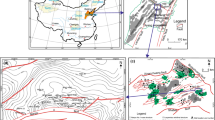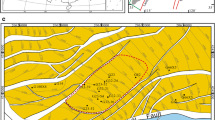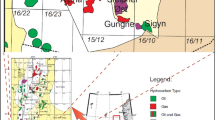Abstract
Horizontal stresses are key parameters of reservoir geomechanics and wellbore stability modeling. For scientific well drilling, where direct measurements are not always available, modeling of horizontal stresses is challenging, especially for highly porous un-compacted gas hydrate-bearing sediments below the seafloor. We have estimated the minimum (Sh) and maximum (SH) horizontal stresses by using rock poro-elastic models based on three wells data which are situated at the national gas hydrate program (NGHP)-01 sites of the offshore Mahanadi basin. The stress magnitudes are validated by wellbore breakout. We have computed the stress magnitudes using 2D seismic for mapping the gas hydrate-bearing sediments. The average gradients of SH and Sh (10.58 MPa/km and 10.48 MPa/km) are less than the gradient of vertical stress, SV (10.67 MPa/km). The present-day stress distribution at the NGHP-01 site is principally a normal faulting (SV > SH > Sh) regime as obtained from stress polygons. The breakouts identified from both formation image and caliper data, suggest a NNW-SSE orientation for SH in the Pleistocene age, which is slightly anti-clock wise relative to the northward oriented of the Indian sub-continent. This change in the orientation of SH could be due to a local structure/fault system cross-cutting the bottom simulating reflector, and mass sliding/slumping on the seafloor. The orientation of SH varies from N11.25°W to N25.7°W of D-quality. We have analysed wellbore stability using the Mohr–Coulomb circle and hoop stress techniques. These results will enable numerical modeling of production from gas hydrate reservoirs planned for the future.
Article Highlights
-
1.
Identification of breakout from formation image and caliper log data and hence, orientation of horizontal stress in the gas hydrates-bearing sediments of the offshore Mahanadi basin.
-
2.
Magnitude of the maximum horizontal stress at breakout intervals and the continuous profile of the horizontal stresses using both well data at NGHP-01 sites and multi-channel seismic data.
-
3.
Analysis of stress polygons, Mohr circles and hoop stress distributions at the selected depth intervals near the gas hydrate-bearing sediments.















Similar content being viewed by others
Explore related subjects
Discover the latest articles, news and stories from top researchers in related subjects.References
Almalikee HS, Alnajm FM (2019) Estimation of minimum and maximum horizontal stresses from well log, a case study in Rumaila oil field, Iraq. Geochem Geophys Geosyst 78–90
Anderson EM (1951) The dynamics of faulting and dyke formation with application to Britain. Oliver and Boyed, Edinburgh, 206p
Baouche R, Sen S, Chaouchi R, Ganguli SS (2021) Modeling In-situ tectonic stress state and maximum horizontal stress azimuth in the Central Algerian Sahara—a geomechanical study from El Agreb, El Gassi and Hassi Messaoud fields. J Nat Gas Sci Eng 88:103831
Barton CA, Zoback MD (1994) Stress perturbations associated with active faults penetrated by boreholes: possible evidence for near-complete stress drop and a new technique for stress magnitude measurement. J Geophys Res Solid Earth 99(B5):9373–9390
Barton CA, Zoback MD, Burns KL (1988) In-situ stress orientation and magnitude at the Fenton Geothermal Site, New Mexico, determined from wellbore breakouts. Geophys Res Lett 15(5):467–470
Barton CA, Zoback MD (2002) Wellbore imaging technologies applied to reservoir geomechanics and environmental engineering. In: Love llM, Parkinson N (eds) Geological applications of welllogs, Vol. 13, AAPG Methods in Exploration, pp 229–239
Bastia R, Nayak P (2006) Tectonostratigraphy and depositional patterns in Krishna offshore basin, Bay of Bengal. Lead Edge 25:839–845
Bastia R, Radhakrishna M, Srinivas T, Nayak S, Nathanial DM, Biswal TK (2010) Structural and tectonic interpretation of geophysical data along the eastern continental margin of India with a special reference to deep water petroliferous basins. J Asian Earth Sci 39:608–619
Biksham G, Subramanian V (1988) Sediment transport of the Godavari river basin and its controlling factors. J Hydrol 101:275–290
Birchwood R, Noeth S (2012) Horizontal stress contrast in the shallow marine sediments of the Gulf of Mexico sites Walker ridge 313 and Atwater Valley 13 and 14–geological observations, effects on wellbore stability, and implications for drilling. Mar Pet Geol 34(1):186–208
Chatterjee R, Mukhopdhyay M (2002) In-situ stress determination using well log data for the oil fields of the Krishna-Godavari basin. Petrophysics 43:26–27
Chatterjee R, Singha DK (2018) Stress orientation from image log and estimation of shear wave velocity using multiple regression model: a case study from Krishna- Godavari basin, India. J Indian Geophys Union 22:128–137
Collett TS, Riedel M, Cochran J, Boswell R, Presley J, Kumar P, Sathe A, Sethi A, Lall M, Sibal V (2008) The NGHP expedition 01 scientists, national gas hydrate program expedition 01 initial reports. Directorate General Hydrocarb New Delhi
Cook A, Goldberg D (2018) Stress and gas hydrate-filled fracture distribution, Krishna- Godavari basin, India. In: Proceeding of the 6th international conference on gas hydrate, Vancouver, British Columbia, Canada, July 6–10, 2008
Das PK, Datta S (2012) Paleogene low stand deep water canyon fill deposits in Mahanadi offshore Basin: can it prove to be the elusive major hydrocarbon discovery? In: 9th Biennial international conference on experimental on petroleum geophysics, Hyderabad, India Paper ID: 31
Das B, Chatterjee R (2017) Wellbore stability analysis and prediction of minimum mud weight for few wells in Krishna-Godavari Basin, India. J Rock Mech Mining Sci 93:30–37
Das B, Chatterjee R (2018) Mapping of pore pressure, in-situ stress, and brittleness in unconventional shale reservoir of Krishna-Godavari basin. J Nat Gas Sci Eng 50:74–89
Dewangan P, Sriram G, Ramprasad T, Jaiswal O (2011) Fault system and thermal regime in the vicinity of site NGHP-01-10 Krishna-Godavari Basin, Bay of Bengal. Marine Petrol Geol 28:1899–1914
Eaton BA (1972) The effect of overburden stress on geopressure prediction from well logs. J Petrol Technol 24(08):929–934
Fowler MJ, Weir FM (2008) The use of borehole breakout for geotechnical investigation of an open-pit mine. In: Potvin Y, Carter J, Dyskin A, Jeffrey R (eds) SHRMS 2008
Fuloria RC (1993) Geology and hydrocarbon prospects of Mahanadi Basin, India. In: Proceedings of the 2nd seminar on "Petroliferous Basin in India". Vol. 3, Indian Petroleum, Publication Dehra Dun, 355–369
Hampson D, Russell B (2013) Joint simultaneous inversion of PP and PS Angle Gathers. CSEG recorder, 34–39
Heidbach O, Reinecker J, Tingay M, Müller B, Sperner B, Fuchs K, Wenzel F (2007) Plate boundary forces are not enough: second- and third-order stress patterns highlighted in the world stress map database. Tectonics. https://doi.org/10.1029/2007TC002133
Horsrud P (2001) Estimating mechanical properties of shale from empirical correlations. SPE Drill Comp 16:68–73
Hyodo M, Yoenda J, Yoshimoto N, Nakata Y (2013) Mechanical and dissociation of methane gas hydrate-bearing sand in deep seabed. Soils Found 53(2):299–314
Jaeger JC, Cook NG (1979) Fundamentals of rock mechanics. 3rd edition.xix+593 pp, numerous figs. London: Chapman and Hall, Vol 117, Issue 4—N. H. W, ISBN 0 412 22010
Jagannathan CR, Ratnam C, Baishya NC, Dasgupta U (1983) Geology of offshore Mahanadi basin. Petrol Asia J 6:101–104
Jang J, Dai S, Yoenda J, Waite WF, Stern LA, Boze LG, Collect TS, Kumar P (2019) Pressure core analysis of geomechanical and fluid flow properties of seal associated with gas hydrate-bearing reservoirs in Krishna-Godavari basin, offshore India. Marine Petrol Geol
Kirsch G (1898) Die Theorie der Elastizitat und die Bedurfnisse der Festigkeitslehre. VDI Z 42:707
Kumar P, Collett TS, Boswell R, Cochran JR, Lall M, Mazumdar A, Ramana MV, Ramprasad TVM, Sain K, Sathe AV, Vishwanath K, Yadav US (2014) Geologic implications of gas hydrates in the offshore of India: Krishna Godavari Basin Mahanadi Basin, Andaman Sea, Kerala Konkan Basin. Marine Petrol Geol 58:29–98
Kvenvolden KA (1993) Gas hydrates as a potential energy resource – a review of their methane content. In: Howell DG et al. (ed.) The future of energy gases, US geological survey professional paper, vol 1570, pp 555–561
Lang J, Li S, Zang J (2011) Wellbore stability modelling and real-time surveillance for deepwater drilling to weak bedding planes and depleted reservoirs. SPE/IADC 139708, Drilling conference and exhibition, Amsterdam, The Netherlands, 1–3 March 2011
Latimer RB, Davison R, Riel PV (2000) An interpreter’s guide to understanding and working with seismic-derived acoustic impedance data. Lead Edge 19:242–256
Lee JY, Francisa FM, Santamarina JC, Ruppel C (2010) Parametric study of the physical properties of hydrate-bearing sand, silt, and clay sediments. J Geophys Res 115:B11105
Lin H, Oh J, Canbulat I, Stacey TR (2020) Experimental and analytical investigations of the effect of hole size on borehole breakout geometries for estimation of in situ stresses. Rock Mech Rock Eng 53(2):781–798
Lund Snee J, Zoback MD (2020) Multiscale variations of the crustal stress field throughout North America. Nat Commun 11:1951. https://doi.org/10.1038/s41467-020-15841-5
Morley CK (2010) Stress re-orientation along zones of weak fabrics in rifts: an explanation for pure extension in ‘oblique’ rift segments. Earth Planet Sci Lett 297(3–4):667–673
Morozov IB, Jinfeng Ma (2009) Accurate post-stack acoustic impedance inversion by well log calibration. Geophysics 74(5):59–67
Muller RD, Yatheesh V, Shuhail M (2015) The tectonic stress field evolution of India since the Oligocene. Gondwana Res 28:612–624. https://doi.org/10.1016/j.gr.2014.05.008
Peska P, Zoback MD (1995) Compressive and tensile failure of inclined wellbores and determination of in situ and rock strength. J Geophys Res 100:12791–12811
Rai N, Singha DK, Shukla PK, Sain K (2020) Delineation of discontinuity using multi-channel seismic attributes: an implication for identifying fractures in gas hydrate sediment in offshore Mahanadi basin. Result Geophys Sci 1–4:100007
Rajabi M, Tingay M, King R, Heidbach O (2017) Present-day stress orientation in the Clarence Moreton Basin of New South Wales, Australia: a new high-density dataset reveals local stress rotations. Basin Res 29:622–640
Ramana MV, Ramprasad T, Desa M, Sathe AV, Sethi AK (2006) Gas-hydrate related proxies inferred from multidisciplinary investigation in the Indian offshore areas. Curr Sci 91:183–189
Ramprasad T, Dewangan P, Ramana MV, Mazumdar A, Karisiddaiah SM, Ramya ER, Sriram G (2011) Evidance of slumping/sliding in Krishna-Godavari offshore basin due to gas/fluid movement. Marine Petrol Geol 28:1806–2816
Russell B, Hampson D, Schuelke J, Quirein J (1998) Multi-attribute seismic analysis. Lead Edge 16:1439–1444
Russell B, Hampson D (1991) Comparison of post-stack inversion methods. In: 61st annual international meeting. Expanded abstracts, vol 10. SEG, Houston, Texas, pp 876 –878
Sain K, Gupta HK (2012) Gas hydrates in India: potential and development. Gondwana Res 22:645–657
Sain K, Ojha M, Satyavani N, Rammadas GA, Ramaprasad T, Das SK, Gupta H (2012) Gas-hydrates in Krishna-Godavari and Mahanadi basins: new data. J Geol Soc India 79:553–556
Sastri VV, Sinha RN, Singh G, Murti KVS (1973) Stratigraphy and tectonics of sedimentary basins on the east coast of peninsular India’. AAPG Bull 57:655–678
Sastri VV, Venkatachala BS, Narayanan V (1981) The evolution of the east coast of India. Palaeogeogr Palaeoclimatol Palaeoecol 36:23–54
Sen MK, Stoffa PL (2013) Global optimization methods in geophysical inversion. Cambridge University Press
Shankar U, Sain K, Riedel M (2012) Geothermal modeling for the base of gas hydrate stability zone and saturation of gas hydrate in the Krishna-Godavari Basin, Eastern Indian Margin, India. J Geol Survey India 79:199–209
Shukla PK, Singha DK, Sain K (2022) 2022, Anisotropy analysis in sallow marine gas hydrate-bearing sediments: a case study from the offshore Mahanadi basin. India Marine Geophys Res 43:3
Singha DK, Chatterjee R (2014) Detection of overpressure zones and a statistical model for pore pressure estimation from well logs in the Krishna-Godavari basin. India Geochem Geophys Geosyst 15:1009–1020
Singha DK, Shukla PK, Chatterjee R, Sain K (2019) Multi-channel 2D seismic constraints on pore pressure- and vertical stress-related gas hydrate in the deep offshore of the Mahanadi basin, India. J Asian Earth Sci 180(2019):103882
Tingay M, Reinecker J, Muller B (2008) Borehole breakout and drilling-induced fracture analysis from image logs. In: World stress map project guidelines: image logs. Analysis guideline breakout image Pdf. Accessed 12 Mar 2018
Uchida S, Soga K, Yamamoto K (2012) Critical state soil constitutive model for methane gas hydrate soil. J Geophys Res 117:1–12
Uchida S, Seol Y, Yamamoto K (2019) Geomechanical behavior of gas hydrate-bearing reservoir during gas production. Search Discov Article 42428
Wang X, Xu Y, Jackson RL (2017) Elastic–plastic sinusoidal waviness contact under combined normal and tangential loading. Tribol Lett 65:45
Yang SX, Yao R, Cui XF, Chen QC, Huang LZ (2012) Analysis of the characteristics of measured stress in Chinese mainland and its active blocks and North-South seismic belt. China J Geophys Chin Ed 55(2012):4207–4217
Zoback MD (2010) Reservoir geomechanics. Cambridge University Press, Cambridge
Zoback MD, Moos D, Mastin L (1985) 1985, Well-bore breakouts and in-situ stress. J Geophys Res 90(B7):5523–5530
Zoback MD, Barton CA, Brudy M, Castillo DA, Finkbeiner T, Grollimund BR, Moos DB, Peska P, Ward CD, Wiprut DJ (2003) Determination of stress orientation and magnitude in deep wells. Int J Rock Mech Min Sci 40:1049–1076
Zoback MD (2007) Reservoir geomechanics, Cambridge University Press, Cambridge, pp 1–445 (ISBN 978-0-521-77069-9)
Acknowledgements
Authors' are thankful to the DST-INSPIRE, Delhi, for funding the project (DST/Inspire Faculty award/2016/Inspire/04/2015/001681) dated 10-08-2015. The authors acknowledge to the head of the gas hydrate section and director CSIR-NGRI, Hyderabad and Directorate General of Hydrocarbon (DGH), New Delhi for providing us with NGHP-01 wells, 2D seismic data, and other geological information.
Funding
Department of science and technology, DST/Inspire Faculty award/2016/Inspire/04/2015/001681) dated 10-08-2015, Dip Kumar Singha.
Author information
Authors and Affiliations
Corresponding author
Ethics declarations
Conflict of interest
On behalf of all authors, the corresponding author states that there is no conflict of interest among authors and regarding data for possible publication the manuscript in the Journal of Geomechanics and Geophysics for Geo-Energy and Geo-Resources.
Additional information
Publisher's Note
Springer Nature remains neutral with regard to jurisdictional claims in published maps and institutional affiliations.
Rights and permissions
About this article
Cite this article
Shukla, P.K., Singha, D.K. & Sain, K. Modeling of in-situ horizontal stresses and orientation of maximum horizhontal stress in the gas hydrate-bearing sediments of the Mahanadi offshore basin, India. Geomech. Geophys. Geo-energ. Geo-resour. 8, 90 (2022). https://doi.org/10.1007/s40948-022-00401-6
Received:
Accepted:
Published:
DOI: https://doi.org/10.1007/s40948-022-00401-6




